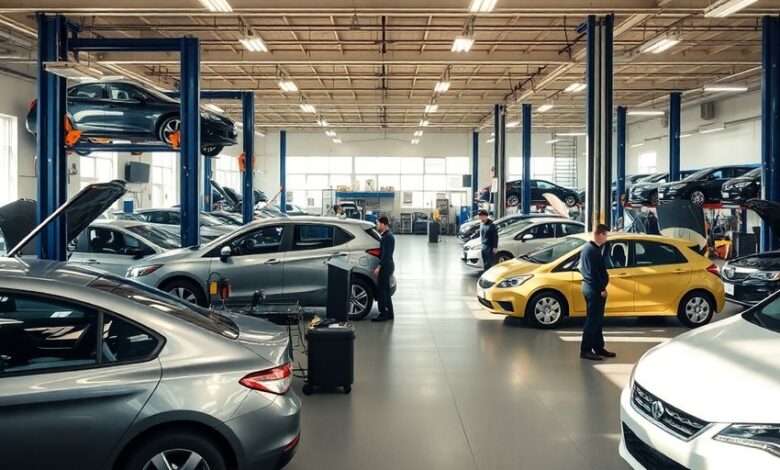
Thinking about starting your own mechanic shop in 2025? You’re not alone! Many people are great with cars but unsure about how to launch a successful business. Don’t worry, we’ve got you covered. In this guide, we’ll walk you through the 7 essential tips for opening a mechanic shop that can help you avoid common pitfalls and set you up for success.
Key Takeaways
- Create a detailed business plan to outline your goals and strategies.
- Choose a prime location that attracts customers and is easy to access.
- Invest in quality equipment to ensure efficient service.
- Implement reliable software for managing appointments and customer data.
- Focus on exceptional customer service to build loyalty.
1. Business Plan
Okay, so you wanna open a mechanic shop, huh? Cool. First thing’s first: you absolutely need a solid business plan. I know, I know, sounds boring, but trust me, it’s super important. Think of it as your shop’s roadmap. Without it, you’re basically driving blindfolded. And nobody wants that, especially when dealing with cars.
A well-thought-out business plan acts as a guide, helping you estimate where your mechanic shop should be in a certain amount of time.
So, what should be in this magical business plan? Glad you asked!
- What services will you offer? Will you specialize in routine maintenance, or will you focus on more complex repairs?
- What’s your pricing strategy? How will you make sure you’re making money without scaring away customers?
- What are your startup costs? This includes everything from equipment to rent to those comfy chairs in the waiting area.
- What are your ongoing expenses? Don’t forget about things like utilities, employee salaries, and automotive repair shop insurance.
It’s important to be realistic about your total costs and revenue. Surprises are fun on birthdays, not when you’re trying to run a business. Get a handle on your finances early on, and you’ll be in a much better position to succeed.
Think of your business plan as a living document. It’s not set in stone. You can adjust it as needed. The market changes, your services might evolve, and that’s okay. The important thing is to have a plan in the first place. Get some colleagues to review the plan and share their input with you. Use attention to detail and avoid mistakes that will set you back after planning is complete.
2. Location

Okay, so you’ve got the business plan down. Now comes the really tricky part: where to actually put your shop. This isn’t just about finding a cheap lease; it’s about setting yourself up for success, or, let’s be real, failure. The right location can make or break your business.
Think about it. A shop tucked away in an industrial park might have lower rent, but will anyone actually find you? On the flip side, a prime spot on Main Street is going to cost you, but you’ll get way more foot traffic. It’s a balancing act, for sure. You need to consider a lot of factors, and it’s not a decision to take lightly. You might want to check out some profitable dropshipping products for 2025 to sell in your shop.
Location is more than just an address; it’s about accessibility, visibility, and the overall vibe of the area. It’s about understanding your target customer and putting yourself where they are.
Here’s a few things to keep in mind:
- Visibility: Can people easily see your shop from the road? Is there clear signage? If not, you’re already at a disadvantage.
- Accessibility: Is it easy for customers to get to your shop? Is there ample parking? A shop that’s a pain to get to is a shop that people will avoid.
- Competition: Are there other mechanic shops nearby? If so, what are they doing well? What are they doing poorly? Can you offer something different or better?
- Demographics: Does the area have a population that needs your services? Are there a lot of older cars on the road? Are there a lot of families with multiple vehicles?
Finding the perfect spot takes time and research, but it’s worth it. Don’t rush this step. Do your homework, talk to other business owners in the area, and get a feel for the neighborhood. Your future depends on it.
3. Equipment
Okay, so you’ve got your business plan sorted and a sweet location picked out. Now comes the fun part (for some of us, anyway): getting all the equipment you’ll need. This isn’t just about buying a bunch of shiny new tools; it’s about making smart investments that will pay off in the long run.
Having the right equipment is crucial for efficiency and quality service. You don’t want to be stuck with outdated gear that slows you down or, worse, gives inaccurate results. Think about it – happy customers mean repeat business, and that starts with having the right tools for the job.
Here’s a quick rundown of some things you’ll probably need:
- Vehicle Lifts: Can’t do much without getting a car in the air, right?
- Diagnostic Tools: Modern cars are computers on wheels. You’ll need the software to talk to them.
- Air Compressors: Powering a lot of your tools, so get a good one.
- Hand Tools: Wrenches, sockets, screwdrivers – the basics that never go out of style.
- Welding Equipment: For those bigger repair jobs.
Don’t forget about safety equipment either. Things like eye protection, gloves, and proper ventilation are non-negotiable. It’s not just about keeping your employees safe; it’s also about avoiding potential lawsuits down the road.
And remember, you don’t have to buy everything brand new. There are plenty of reliable used equipment options out there. Just do your homework and make sure you’re getting something that’s still in good working order. You might even consider SBA loan options to help finance these purchases. After all, you want to properly lubricate your air tools to keep them running at peak performance.
4. Software
Okay, so you’ve got the location, the tools, and a solid plan. Now, let’s talk about the brains of the operation: software. In 2025, running a mechanic shop without the right software is like trying to fix a car with a hammer and duct tape – possible, but not pretty. You need software to manage everything from appointments to invoices, and even customer relationships. It might seem like a big expense, but trust me, it’s worth it.
Think of it as an investment, not just an expense.
One shop owner I talked to mentioned spending around $1,000 a month on software subscriptions. That sounds like a lot, but he swore it paid for itself in increased efficiency and customer satisfaction.
The right software can streamline your operations, improve customer communication, and ultimately, boost your bottom line. It’s about working smarter, not harder.
Here are a few things to consider:
- Shop Management Software: This is your all-in-one solution. It handles scheduling, invoicing, inventory, and customer data. Look for something that’s easy to use and integrates with other tools.
- Diagnostic Software: Modern cars are basically computers on wheels. You’ll need software to diagnose problems, access repair information, and update vehicle systems. Mitchell1 is a popular option.
- Customer Relationship Management (CRM): Keeping your customers happy is key to repeat business. A CRM helps you track customer interactions, send reminders, and manage marketing campaigns.
- Accounting Software: QuickBooks is a common choice for small businesses. It helps you manage your finances, track expenses, and prepare taxes.
- Digital Inspection Tools: Software like Bolt On Technology allows you to perform digital inspections, include images in invoices, and build trust with customers.
Having a professional website is also a must. It’s your digital storefront, so make sure it looks good and is easy to navigate. You can use website builders like WordPress or Wix, but get a custom domain to avoid looking unprofessional.
5. Marketing Strategy
Okay, so you’ve got the shop, the tools, and maybe even some fancy auto repair management software. Now, how do you get people to actually bring their cars to you? That’s where marketing comes in. Honestly, it’s not as scary as it sounds. Think of it as just letting people know you exist and that you’re good at what you do.
- A solid marketing plan is key.
- Don’t just throw money at ads and hope for the best.
- Figure out who your ideal customer is and where they spend their time, both online and offline.
I remember when my cousin Vinny opened his shop. He thought just putting up a sign was enough. He waited and waited for customers. He ended up closing down after a year. Don’t be like Vinny.
a. Online Presence
First things first, get online. I mean, really get online. A website is a must, even if it’s just a simple one with your address, phone number, and a list of services. But don’t stop there. Social media is your friend. Post pictures of cool cars you’re working on, share helpful tips, and run some targeted ads. Think about it: people search for “mechanic near me” all the time. Make sure your shop pops up!
b. Local Partnerships
Don’t underestimate the power of local connections. Partner with other businesses in your area. Maybe the local car wash can hand out your flyers, or you can offer a discount to employees of a nearby company. Think outside the box! Networking is a great way to identify a niche market and get your name out there.
c. Customer Loyalty Programs
Keep those customers coming back! Start a loyalty program. Offer discounts for repeat business, send out birthday cards, or even just remember their names when they come in. People appreciate feeling valued, and they’re more likely to recommend you to their friends. Word-of-mouth is still one of the best forms of advertising, after all.
d. Traditional Marketing
Don’t completely ditch traditional marketing. While digital is important, things like marketing services in local newspapers or sponsoring a community event can still be effective, especially for reaching older demographics. Think about sponsoring a local little league team or putting an ad in the high school football program. It’s all about finding the right mix for your target audience.
6. Customer Service

Customer service can make or break your shop. It’s not just about fixing cars; it’s about making people feel valued and heard. If a customer has a bad experience, they probably won’t come back, and they might tell their friends. Word of mouth is still a powerful thing.
Good customer service leads to repeat business and positive reviews.
Here’s what I’ve learned about keeping customers happy:
- Always listen to the customer’s concerns. Don’t interrupt or dismiss them.
- Explain the repair process clearly. Use simple language, not technical jargon.
- Be transparent about costs. No one likes surprise bills.
- Follow up after the repair. Make sure they’re satisfied with the work.
I remember one time, we misdiagnosed a car. Instead of arguing with the customer, we owned up to the mistake and fixed it for free. They were so impressed with our honesty that they became a regular customer and recommended us to everyone they knew.
Think about ways to make the waiting area more comfortable. Offer free Wi-Fi, coffee, or magazines. Small things can make a big difference. Also, train your employees to be friendly and helpful. Their attitude can affect the customer’s experience.
Consider implementing a system for gathering customer feedback. This could be as simple as a comment card or an online survey. Use this feedback to improve your service. If you get a negative review, respond to it promptly and professionally. Show that you care about their concerns. Customer service is an ongoing process, not a one-time thing.
7. Employee Training
Okay, so you’ve got the location, the equipment, and even some fancy software. But let’s not forget the people who’ll actually be turning those wrenches! Good employee training is super important. I mean, you can’t expect everyone to walk in knowing everything, right?
- Ongoing Training: The automotive world is always changing. New car models, new technologies… it never stops. Make sure your employees are up-to-date.
- Certifications Matter: Encourage your mechanics to get certified. It shows they know their stuff and it can bring in more customers. auto mechanic training is a must.
- Shadowing and Mentorship: Pair up new employees with experienced ones. It’s a great way for them to learn the ropes and get comfortable.
Don’t just throw your employees into the deep end. Invest in their development, and it’ll pay off in the long run. Happier, more skilled employees mean better service and fewer mistakes. Plus, they’re more likely to stick around.
Think about it: a well-trained team can handle more complex repairs, provide better customer service, and ultimately, make your shop more profitable. It’s a win-win!
Wrapping It Up
So there you have it! Starting a mechanic shop in 2025 isn’t just about knowing cars; it’s about planning and connecting with your community. Keep your finances in check, hire the right people, and don’t forget to market yourself. It might feel overwhelming at first, but with the right approach, you can build a successful business. Remember, every big journey starts with a single step. So, get out there, put these tips into action, and make your mechanic shop a reality!
Frequently Asked Questions
What is the first step to opening a mechanic shop?
The first step is to create a solid business plan. This plan should outline your goals, target market, and financial projections.
How much money do I need to start a mechanic shop?
Starting a mechanic shop can cost between $50,000 to $100,000, depending on equipment, location, and other expenses.
What should I consider when choosing a location?
Look for a place that is easy to find, has good visibility, and is close to your target customers. Rent and space for your shop are also important.
What type of equipment do I need?
You will need basic tools, diagnostic machines, and safety equipment. Make sure to invest in quality tools to provide the best service.
How can I market my new mechanic shop?
Use social media, local ads, and word-of-mouth to attract customers. Building a website is also a great way to showcase your services.
Why is customer service important for my shop?
Good customer service helps build trust and keeps customers coming back. Happy customers are more likely to recommend your shop to others.



